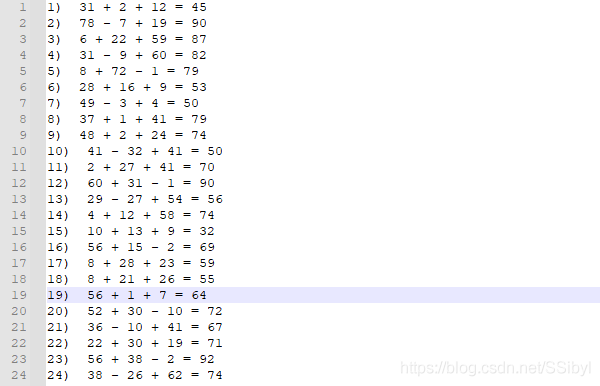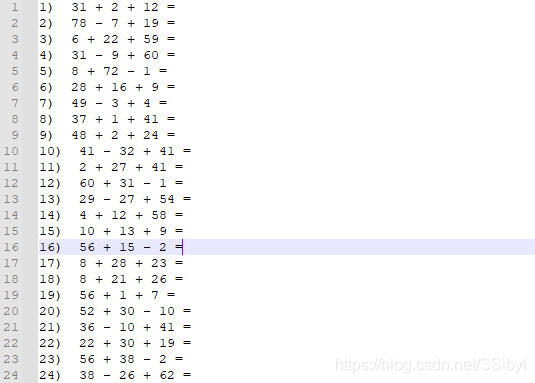- ubuntu12.04环境下使用kvm ioctl接口实现最简单的虚拟机
- Ubuntu 通过无线网络安装Ubuntu Server启动系统后连接无线网络的方法
- 在Ubuntu上搭建网桥的方法
- ubuntu 虚拟机上网方式及相关配置详解
CFSDN坚持开源创造价值,我们致力于搭建一个资源共享平台,让每一个IT人在这里找到属于你的精彩世界.
这篇CFSDN的博客文章Python趣味挑战之给幼儿园弟弟生成1000道算术题由作者收集整理,如果你对这篇文章有兴趣,记得点赞哟.
阿姨花了30元给幼儿园的小弟弟买了一本习题,里面都是简单的二元加减法。我一听,惊道:“怎么还花钱买题?我动动手指能给你生成一千条。” 。
阿姨觉得二元加减太简单了,想要三元加减法的算术题(x + y + z; x + y - z; x - y - z; x - y + z),因为弟弟还小,只会100以内的加减法,不会负数,所以出的算术题不仅计算结果要在[0, 100]内,算式中的任何两位的计算也要在[0, 100]内.
希望弟弟长大后会感谢我,嘻嘻~ 。
生成在[1,99]内的随机数x, y, z,若它们的计算结果在[0, 100]内,且算式中的任何两位的计算也在[0, 100]内,就保存在字符串里,作为答案,如"10 + 13 + 9 = 32";将字符串存入set中,因为Python的set是无序且不重复的,所以它会自动打乱和去重;把答案写入文件,写入文件时要写入index(题号)去掉结果再写入另一个文件,作为题目 。
1.生成随机整数:
import randomx = random.randint(1, 99) # 生成[1, 99]内的整数
2.set:
s = set() # 初始化要用set()x = 1s.add(x) # 将x插入s
3.将结果存入文件 。
text = "Hello world!"with open(file, 'a') as f: # 追加文本到文件 # 每次输入前清空文件 f.seek(0) f.truncate() # 将文本写入文件 f.write(text)
import randomdef fun1(x, y, z): s = str(x) + " + " + str(y) + " + " + str(z) + " = " + str(x + y + z) return sdef fun2(x, y, z): s = str(x) + " + " + str(y) + " - " + str(z) + " = " + str(x + y - z) return sdef fun3(x, y, z): s = str(x) + " - " + str(y) + " + " + str(z) + " = " + str(x - y + z) return sdef fun4(x, y, z): s = str(x) + " - " + str(y) + " - " + str(z) + " = " + str(x - y - z) return sdef generate(num): s = set() while len(s) < num: x = random.randint(1, 99) y = random.randint(1, 99) z = random.randint(1, 99) if ((x + y >= 0 and x + y <= 100) and (y + z >= 0 and y + z <= 100) and (x + z >= 0 and x + z <= 100) and (x + y + z >= 0 and x + y + z <= 100)): s.add(fun1(x, y, z)) if ((x + y >= 0 and x + y <= 100) and (y - z >= 0 and y - z <= 100) and (x - z >= 0 and x - z <= 100) and (x + y - z >= 0 and x + y - z <= 100)): s.add(fun2(x, y, z)) if ((x - y >= 0 and x - y <= 100) and (- y + z >= 0 and - y + z <= 100) and (x + z >= 0 and x + z <= 100) and (x - y + z >= 0 and x - y + z <= 100)): s.add(fun3(x, y, z)) if ((x - y >= 0 and x - y <= 100) and (- y - z >= 0 and - y - z <= 100) and (x - z >= 0 and x - z <= 100) and (x - y - z >= 0 and x - y - z <= 100)): s.add(fun4(x, y, z)) return sdef save_in_file(answers, answer_file, question_file): with open(answer_file, 'a') as f: # 每次输入前清空文件 f.seek(0) f.truncate() cnt = 1 for ans in answers: text = str(cnt) + ") " + ans + '\n' f.write(text) cnt += 1 with open(question_file, 'a') as f: f.seek(0) f.truncate() cnt = 1 for ans in answers: ques = str(cnt) + ") " + ans[: ans.find('=') + 1] + "\n" f.write(ques) cnt += 1save_in_file(generate(1000), "C:\\Users\\sibyl\\Desktop\\calculation\\answer.txt", "C:\\Users\\sibyl\\Desktop\\calculation\\question.txt")
生成的txt文件:


排版后的word文档:


到此这篇关于Python趣味挑战之给幼儿园弟弟生成1000道算术题的文章就介绍到这了,更多相关Python生成算术题内容请搜索我以前的文章或继续浏览下面的相关文章希望大家以后多多支持我! 。
原文链接:https://blog.csdn.net/SSibyl/article/details/117287154 。
最后此篇关于Python趣味挑战之给幼儿园弟弟生成1000道算术题的文章就讲到这里了,如果你想了解更多关于Python趣味挑战之给幼儿园弟弟生成1000道算术题的内容请搜索CFSDN的文章或继续浏览相关文章,希望大家以后支持我的博客! 。

我是一名优秀的程序员,十分优秀!